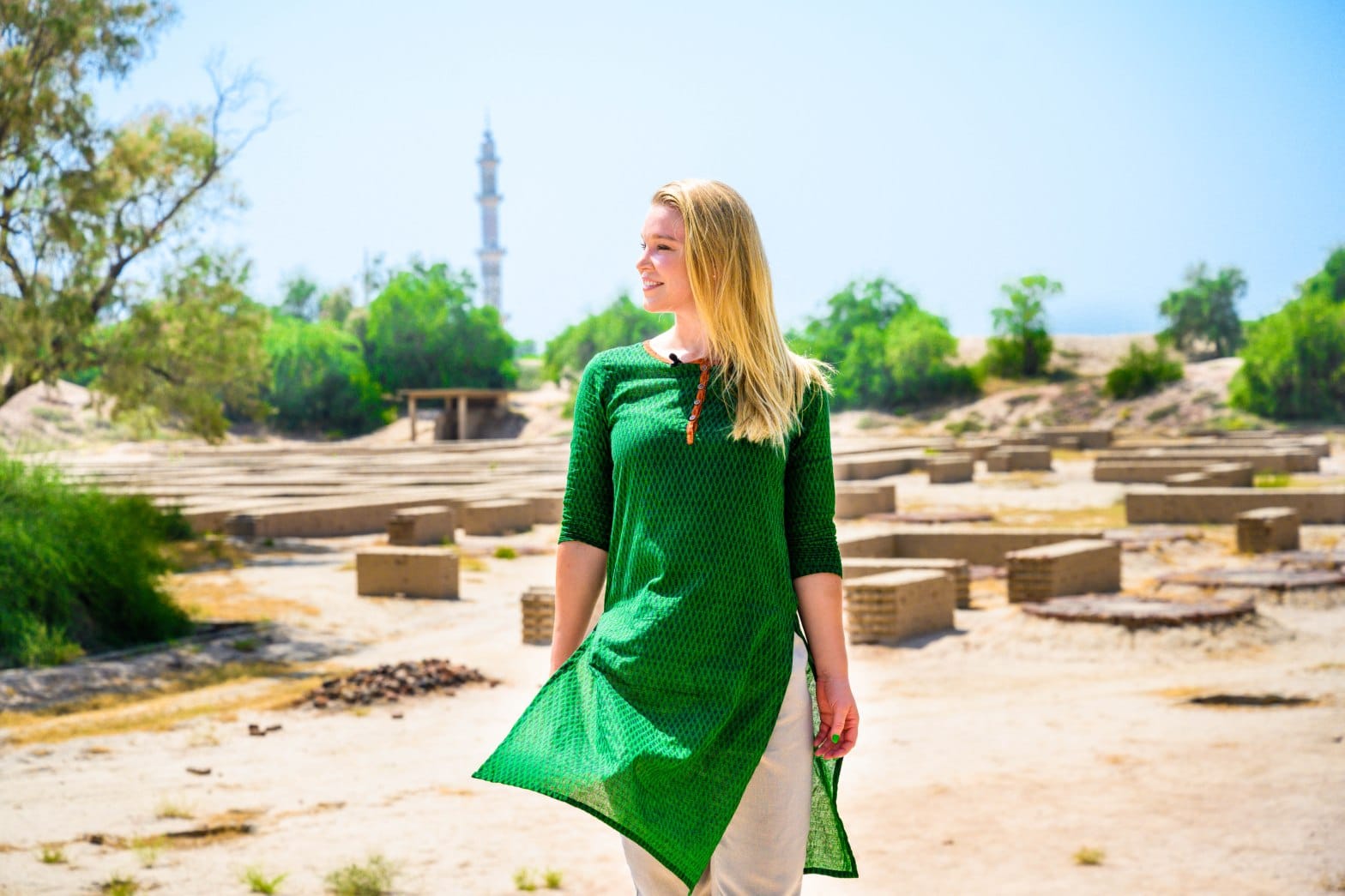With approximately 212 million people, Pakistan is the world’s sixth most populated country.
Pakistan is divided into two autonomous regions, four provinces, and one federal territory, each with its distinctive traditional dress.
Every regional culture’s traditional clothing reflects their way of life and weather circumstances.
For thousands of years, traditional Pakistani clothing has been strongly impacted by many civilizations and is regarded as a heritage of the old civilization.

Below are some of the different types of Pakistani clothing.
1. Shalwarkameez
The shalwarkameez is one of the different types of traditional Pakistani clothing popular throughout the Indian subcontinent.
The Kameez also comes in a variety of styles depending on where it’s worn. A shalwar (buggy trouser) and a kameez (long shirt) are part of the outfit.
Pakistani ladies frequently wear a scarf with their shalwarkameez. The shalwar’s legs are thin at the ankle and broad at the top.
The Kameez is a long tunic or shirt with a Western-style collar for men and a collarless version for ladies. Natives might wear a kameez with their pajamas for comfort or fashion.
2. Sherwani
The sherwani is a must-have for traditional Pakistani men’s attire. We’re all familiar with Pakistani wedding customs.
Any wedding would be completed without the groom wearing a sherwani. Even the groom’s guests join the fun, wearing modest embroidered sherwanis for a clean yet traditional look.
Sherwanis are fashioned of somewhat heavier fabric to obtain a rigid form. They’re similar to long shirts with a unique collar known as a sherwani collar.
Sherwani, for example, is one of the different types of traditional Pakistani clothing with only one pocket.
Sherwani bottoms are generally tight pants; some like to wear them with a shalwar.
3. Pashmina
Pakistan experiences scorching temperatures for most of the year. However, most parts of Pakistan are also chilly.
Pashmina is a wonderful fabric that is traditionally produced in Kashmir. It is bought and sold throughout Pakistan. Everyone adores Pashmina because it keeps them warm throughout the freezing winter months.
Pashmina is made in Pakistan, yet it is sold throughout Europe. Due to its high worth, it is also in high demand in many regions of the world.
Many royal families and famous people throughout the world prefer this cloth.
4. Balochi Dress
Baluchistan is one of Pakistan’s four provinces. It is also a culturally diverse area with a wide range of delectable food and clothing.
Balochi needlework is well-known throughout Pakistan, and many purchase this traditional clothing. Mirrorwork and exquisite threadwork are used in embroidery.
Balochi clothing is distinguished by pockets. The shirt’s vivid colors and intricate craftsmanship give it a lovely appearance.
Balochi embroidery is always in style in Pakistan and is most commonly worn during the summer months.
5. Lawn
Pakistan is the epicenter of the breathable material known as grass. Every clothing company in Pakistan produces at least three grass collections each year.
Pakistanis, particularly women, look forward to the summer months since it is lawn season. Most of the time, we see females sporting bright colors and amazing patterns for a lower cost.
6. Gharara
If you were born and raised in Pakistan, you have almost certainly worn a gharara at some point in your life.
In Pakistani culture, the gharara is one of the different types of traditional Pakistani clothing that is highly appreciated.
Originally, these unique bottoms were solely worn by elderly ladies. Gharara is becoming a fashionable apparel item.
Women typically wear them at pre-wedding activities. A gharara is a specialized pair of trousers that fits snugly around the thighs and flares out at the bottom.
It’s a type of two-legged pant in various colors and designs.
7. Saraiki Turban
Saraikis are an ethnolinguistic group of people who live in Pakistan’s southeastern and central regions.
The Saraiki people’s traditional clothing is the Shalwarkameez, generally worn with a Saraiki turban.
Turbans used with Saraikishalwar suits used to be enormous and roughly 40 feet long, but there are now a variety of shorter styles.
8. Shindhi Cap
Sindhi cap, also known as Saraikitopi or Sindhi topi, is a traditional Pakistani garment popular in Pakistan’s Sindh province.
Pashtuns, Baloch people, and Saraiki people also use Sindhi caps. SaraikiAjrak and Sindhi are believed to be part of the Saraiki and Sindhi civilizations.
Sindhi is a cylindrical hat with a tiny cutout in the front to reveal the face. Several tiny mirrors are sewn into several of these hats.
In addition, Sindhi Culture Day is observed on the first Sunday of every year, in December.
9. KhetPartug
Khetpartug is a kind of salwarkameez popular in Pakistan’s northern and western regions and Afghanistan.
The khet is the upper garment, while the partug is the bottom. It looks like a robe or tunic and is generally fitted around the waist.
The khet is knee-length and has broad sleeves. In addition, the khet is normally worn with a belt and does not have slits. The partug is pleated and has folds around the waist.
10. Baloch
Baluchistani Pakistanis wear a variety of turban, headscarf, shalwar, and kameez styles.
The men’s Balochi shalwarkameez is also made up of baggy shalwar and loose kameez. Baloch kameez is a long-sleeved dress.
Baloch women wear a shalwar, a long garment, and a headscarf. Baloch ladies wear flowy gowns with native motifs embroidered on them, while Baloch men wear various turbans known as pagri.
11. Churidaar Pajama
Churidaar pajamas are a type of tight-fitting pant popular in the Indian subcontinent.
The Churidar pajamas are long and thin, revealing the leg contours. Sincechuridaars are inherently flexible, they fit snugly.
Churidaar is constructed to be longer than the wearer’s leg and may have a buttoned cuff at the ankles.
The additional length on the ankles generates folds that resemble bangles on ankles. When sitting, the extra material allows the wearer to flex his or her feet.
12. LehengaCholi
The ghagracholi originated from a three-piece traditional Indian clothing that featured a stanapatta (chest band), uttariya (veil), and antriya (skirt) (lower garment).
A choli is a midriff-baring top derived from the stanapatta. It is worn with a sari in many Indian subcontinent countries and shows a woman’s navel.
The gagra is a long, pleated, and embroidered skirt fastened at the hips and exposes the stomach and lower back.
A scarf known as the dupatta, which originated from the uttariya, is generally worn with the choli and gagra.
13. Khussa
Khussa is a fashionable South Asian shoe produced in Pakistan’s Punjab province.
They’re closed-toed shoes with curled toes. The craftspeople use vegetable-tanned leather to create this footwear.
The khussa’s upper portion is made of cloth or leather embroidered with ceramic beads, bells, mirrors, cowry shells, and brass nails.
The upper part is connected to the sole with an eco-friendly cotton thread. During ancient times, the khussa was quite popular among the royals. The footwear comes in a variety of colors and styles.
14. Ajrak
Ajrak is one of the different types of traditional Pakistani clothing that never goes out of style.
It is a component of Sindhi heritage, and the unique ajrak pattern represents their culture. It’s a pattern with blue, black, white, and red that’s generally printed on lawn cloth.
When it comes to ajrak, there are several variants. Men like to wear the fabric around their necks, but women prefer to wear it as a salwarkameez.









what a great idea: talk abouth clothes without showing them
You can search for the clothes online.